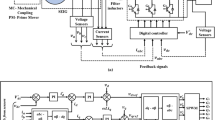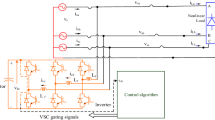Abstract
The main focus of this work is power quality issues such as voltage and frequency fluctuation under load variation, source current distortion and power mismatch between utility and load in a single-phase SEIG-based isolated system. Therefore, this paper addressed the said problems using momentum least mean square control algorithm for single-phase SEIG working in stand-alone operation. The coordinated operation of battery energy storage system and dump load controller is also carried out for better battery performance. The features of this algorithm are its capability to extract desired signal from a fixed amplitude, non-stationary, linear frequency and variable amplitude sinusoidal signals in both noise-free and noisy conditions. The reference current tracking performance is improved by estimating the incremental convergence rate and the momentum term scaled by the factor α in the LMS-based algorithm. Due to the presence of scaling factor with the various weights from preceding two iterations, it is certainly convergent more rapidly. Moreover, it has promised better reliability in reckless atmosphere. This control is verified by computer simulations. The entire system is developed in MATLAB/SIMULINK environment followed by experimental validation of control algorithm.












Similar content being viewed by others
Abbreviations
- SEIG:
-
Self-excited induction generator
- MLMS:
-
Momentum least mean square
- VSC:
-
Voltage source converter
- BESS:
-
Battery energy storage system
- DSTATCOM:
-
Distribution static compensator
- i b :
-
Battery current
- V w :
-
Wind velocity
- v t :
-
Terminal voltage magnitude
- v p :
-
In-phase voltage component
- v q :
-
Quadrature phase voltage component
- u pa :
-
In-phase unit voltage template
- u qa :
-
Quadrature phase unit voltage template
- v b :
-
Battery terminal voltage
- f :
-
System frequency
- i spt :
-
Magnitude of active component of reference current
- i sqt :
-
Magnitude of reactive component of reference current
- w(p):
-
Sample of current weight at pth moment
- i dp :
-
Current loss component in compensator
- i qq :
-
Reactive current component from source
- i * spt :
-
Active component of reference current
- i * sqt :
-
Reactive component of reference current
- i s :
-
Source current
- i * s :
-
Reference source current
- α :
-
Momentum scaling factor
- μ :
-
Learning rate
- ω :
-
Angular frequency
- e(p):
-
Current weight error
- P G, P C, P B, P D :
-
Real power of generation, compensator, battery and demand, respectively
- V dc :
-
DC link voltage
- C dc :
-
DC link capacitor
- C exc :
-
Excitation capacitor
References
El-Sharkawi MA (2015) Wind energy an introduction, 1st edn. CRC Press, Cambridge
Boldea I (2016) Synchronous generators hand book. CRC Press, Cambridge
Lai LL, Chan TF (2007) Distributed generation: induction and permanent magnet generators. Wiley, New York
Chapallaz JM, Ghali JD, Eichenberger P, Fischer G (1992) Manual on induction motors used as generators. Springer, Berlin
Widrow B, Steams SD (1985) Adaptive signal processing. Prentice-Hall, Englewood Cliffs
IEEE Standards 519–2014. IEEE Recommended Practices and Requirements for Harmonic Control in Electric Power Systems.
Chen Z, Guerrero JM, Blaabjerg F (2009) A review of the state of the art of power electronics for wind turbines. IEEE Trans Power Electron 24(8):1859–1875
Zobaa AF (2014) Optimal multi-objective design of hybrid active power filters considering a distorted environment. IEEE Trans Ind Electron 61(1):107–114
Barrado I, Grino R, Blavi H (2010) Power quality improvement of a standalone induction generator using a STATCOM with battery energy storage system. IEEE Trans Power Deliv 25(4):2734–2741
Singh B, Arya SR (2013) Adaptive theory based improved linear sinusoidal tracer control algorithm for DSTATCOM. IEEE Trans Power Electron 28(8):3768–3778
Yang K, Bollen MHJ, Amaris H, Alvarez C (2016) Decompositions of harmonic propagation in wind power plant. J Electric Power Syst Res 141(5):84–90
Loetwassana W, Punchalard R, Koseeyaporn J, Wardkein P (2006) A Modification of Momentum LMS with variable momentum factor. In: Proceedings of international symposium on communications and information technologies, pp 11–14
Chauhan PJ, Chatterjee JK, Bhere H, Perumal BV, Sarkar D (2015) Synchronized Operation of DSP-based generalized impedance controller with variable-speed isolated SEIG for Novel Voltage and Frequency Control. IEEE Trans Ind Appl 51(2):1845–1854
Tugay MA, Tanik Y (1989) Properties of the momentum LMS algorithm. In: Proceedings of MELCON-89, Protugal, pp 197–200
Giri AK, Qureshi A, Arya SR, Maurya R, Chitti Babu B (2018) Features of Power quality in single-phase distributed power generation using adaptive nature vectorial filter. IEEE Trans Power Electron 33(11):9482–9495
Glover JR (1979) High order algorithms for adaptive filters. IEEE Transaction on Communications 27:216–221
Tanrikutu O, Chambers JA, Constantinides AG (1997) Block Momentum LMS algorithm based on the method of parallel tangents. IEE Proc Vis Image Signal Process 144(2):49–56
Shynk JJ, Roy S (1988) The LMS algorithm with momentum updating. In: Proceedings of IEEE international symposium on circuits and system, Helsinki-Finland, vo1 3, pp 2651–2654
Giri AK, Arya SR, Maurya R, Mehar R (2018) Variable learning adaptive gradient based control algorithm for voltage source converter in distributed generation. IET Renew Power Gener 12(16):1883–1892
Tugay MA, Tanik Y (1989) Properties of the momentum LMS algorithm. In: Proceedings of electro-technical conference on integrating research, industry and education in energy and communication engineering (MELECON), Mediterranean, pp 1–4
Roy S, Shynk JJ (1990) Analysis of the momentum LMS algorithm. IEEE Trans Acoust Speech Signal Process 38(2):2088–2098
Kim SH, Jeong JJ, Koo G, Kim SW (2016) Robust convex combination of affine projection-type algorithms using an impulsive noise indicator. J Signal Process 129(5):33–37
Das RL, Narwaria M (2017) Lorentzian based adaptive filters for impulsive noise environments. IEEE Trans Circuits Syst-I 64(6):1529–1539
Singh B, Rajagopal V (2011) Neural-network-based integrated electronic load controller for isolated asynchronous generators in small hydro generation. IEEE Trans Ind Electron 58(9):4264–4274
Giri AK, Arya SR, Maurya R, Chittibabu B (2020) Control of VSC for enhancement of power quality in off-grid distributed power generation. IET Renew Power Gener 14(5):771–778
Kalla UK, Singh B, Sreenivasa Murthy S, Jain C, Kant K (2018) Adaptive Sliding mode control of standalone single-phase micro-grid using hydro, wind, and solar PV array-based generation. IEEE Trans Smart Grid 9(6):6806–6814
Nayanar V, Kumaresan N, Ammasai Gounden N (2016) A Single sensor based MPPT controller for wind-driven induction generators supplying DC Micro-grid. IEEE Trans Power Electron 31(2):1161–1172
Author information
Authors and Affiliations
Corresponding author
Additional information
Publisher's Note
Springer Nature remains neutral with regard to jurisdictional claims in published maps and institutional affiliations.
Appendix
Appendix
1.1 Parameters of SEIG
Parameters: Rms = 2.93 Ω, Lms = 0.0267544 H, Rmr = 3.3077 Ω, Lmr = 0.017544 H, Lms = 0.13814 H, J = 0.00290763 J(Kg m2), Las = 0.024007 H; Ras = 5.0268 Ω, Pole pair = 2, Na/Nm = 1.25; Cexc = 80 µF, Auxiliary load: 240 V, 100 Ω, 500 Watt.
1.2 Parameters of supply, DSTATCOM, loads and control logic
System/components/instruments | Rating/parameter | Values |
|---|---|---|
Generator (SEIG) data | Voltage rating | 220 V |
Power rating | 2.2 kW | |
No. of poles | 04 | |
Frequency | 50 Hz | |
High-frequency ripple filter | Resistance (Rf) | 8 Ω |
Capacitor (Cf) | 12 µF | |
Load parameters | Active power (P) | 2.5 kW |
Reactive power (Q) | 2.5 kVAR | |
PI controller gains | In frequency loop | kp = 0.22, ki = 0.042 |
In terminal voltage control loop | kp = 0.54, ki = 0.23 | |
VSC data | DC bus voltage (Vdc) | 400 V |
Interfacing inductor (Ls) | 4 mH | |
DC bus capacitor (Cdc) | 8000 µF | |
Battery energy storage system | Voltage | 400 V |
Ampere hour capacity | 7.5 Ah | |
Internal resistance | 0.05 Ω |
Rights and permissions
About this article
Cite this article
Qureshi, A., Giri, A.K., Arya, S.R. et al. Power conditioning using DSTATCOM in a single-phase SEIG-based isolated system. Electr Eng 104, 111–127 (2022). https://doi.org/10.1007/s00202-021-01423-1
Received:
Accepted:
Published:
Issue Date:
DOI: https://doi.org/10.1007/s00202-021-01423-1




